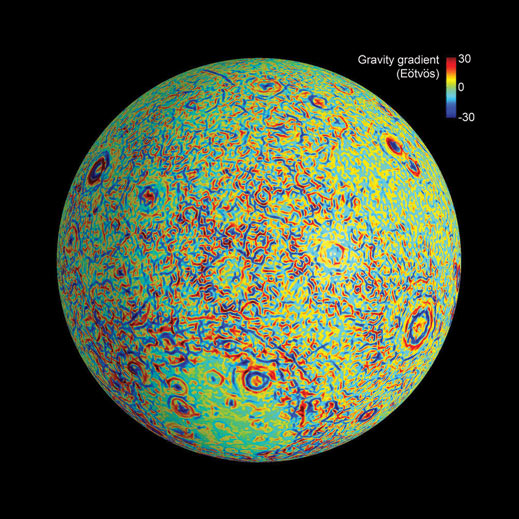The Moon’s Bumpy Gravity
Ever since the first satellites were sent to the moon to scout landing sites for Apollo astronauts, scientists have noticed a peculiar phenomenon: as these probes orbited the moon, passing over certain craters and impact basins, they periodically veered off course, plummeting toward the lunar surface before pulling back up.

As it turns out, the cause of such bumpy orbits was the moon itself. Over the years, scientists have observed that its gravity is stronger in some regions than others, creating a “lumpy” gravitational field. In particular, a handful of impact basins exhibit an unexpectedly strong gravitational pull. Scientists, who suspect that the explanation has to do with an excess distribution of mass below the lunar surface, have dubbed these regions mass concentrations, or “mascons.”
Exactly how these mascons came to be has remained a mystery—until now.
Using high-resolution gravity data from NASA’s Gravity Recovery and Interior Laboratory (GRAIL) mission, researchers at MIT and Purdue University mapped the structure of several mascons and found that their gravitational fields resemble a bull’s-eye pattern: a center of strong gravity surrounded by alternating rings of weak and strong gravity.
To figure out what caused this gravitational pattern, the team created a computer model of lunar impacts and ran the model forward to simulate geological repercussions in the moon’s crust and mantle over both the short and long term. They found that the simulations reproduced the bull’s-eye pattern under just one scenario.
When an asteroid crashes into the moon, it sends material flying out, creating a dense band of debris around the crater’s perimeter. The impact sends a shock wave through the moon’s interior, reverberating within the crust and producing a counterwave that draws dense material from the lunar mantle toward the surface, creating a dense center within the crater. After hundreds of millions of years, the surface cools and relaxes, creating a bull’s-eye that matches today’s gravitational pattern.
This tumultuous chain of events was probably what led to today’s lunar mascons, says Maria Zuber, a professor of geophysics in the Department of Earth, Atmospheric and Planetary Sciences. The team’s results were published in Science.
“For the first time, we have a holistic understanding of the process that forms mascons,” says Zuber, who is also GRAIL’s principal investigator and MIT’s vice president for research. “There will be more details that emerge for sure, but the quality of the GRAIL data enabled rapid progress on this long-standing question.”
Keep Reading
Most Popular
Large language models can do jaw-dropping things. But nobody knows exactly why.
And that's a problem. Figuring it out is one of the biggest scientific puzzles of our time and a crucial step towards controlling more powerful future models.
The problem with plug-in hybrids? Their drivers.
Plug-in hybrids are often sold as a transition to EVs, but new data from Europe shows we’re still underestimating the emissions they produce.
Google DeepMind’s new generative model makes Super Mario–like games from scratch
Genie learns how to control games by watching hours and hours of video. It could help train next-gen robots too.
How scientists traced a mysterious covid case back to six toilets
When wastewater surveillance turns into a hunt for a single infected individual, the ethics get tricky.
Stay connected
Get the latest updates from
MIT Technology Review
Discover special offers, top stories, upcoming events, and more.